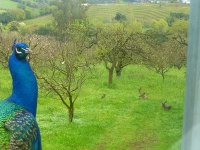Just a couple of thoughts on reviving an old orchard, HillStreet. Do not go crazy for the first year with pruning. Try to take about 1/3 of the old wood out, taking more than that shocks the tree, and it will throw out a huge amount of new growth, which will need to be removed the following spring.
The general rule for pruning older established trees is to try to remove the branches that grow inward, towards the center of the tree, and those that grow pointing upwards. You will notice uncared for apple trees have a lot of beaches or sucker growing straight up towards the sky, you want them to grow downwards or parallel to the ground.
Unless the trees are in very bad condition, they shouldn't need any fertilizer, as it causes excess growth of new foliage, and you want fruit, not leaves. If you do decide to fertilize, use a fertilizer with little to no nitrogen in it.
Copper sulphate or a combination fruit tree spray, is very safe to use on Apple peach and plum trees, start spaying in Feb. and keep going throughout the growing season.
Turning an neglected orchard around is a little like turning a battleship around, it takes time, effort, and diligence. It's an ongoing process. Every year, you prune and spray, and at the same time, the tree tries to revert to the condition you started with in the first place.r


